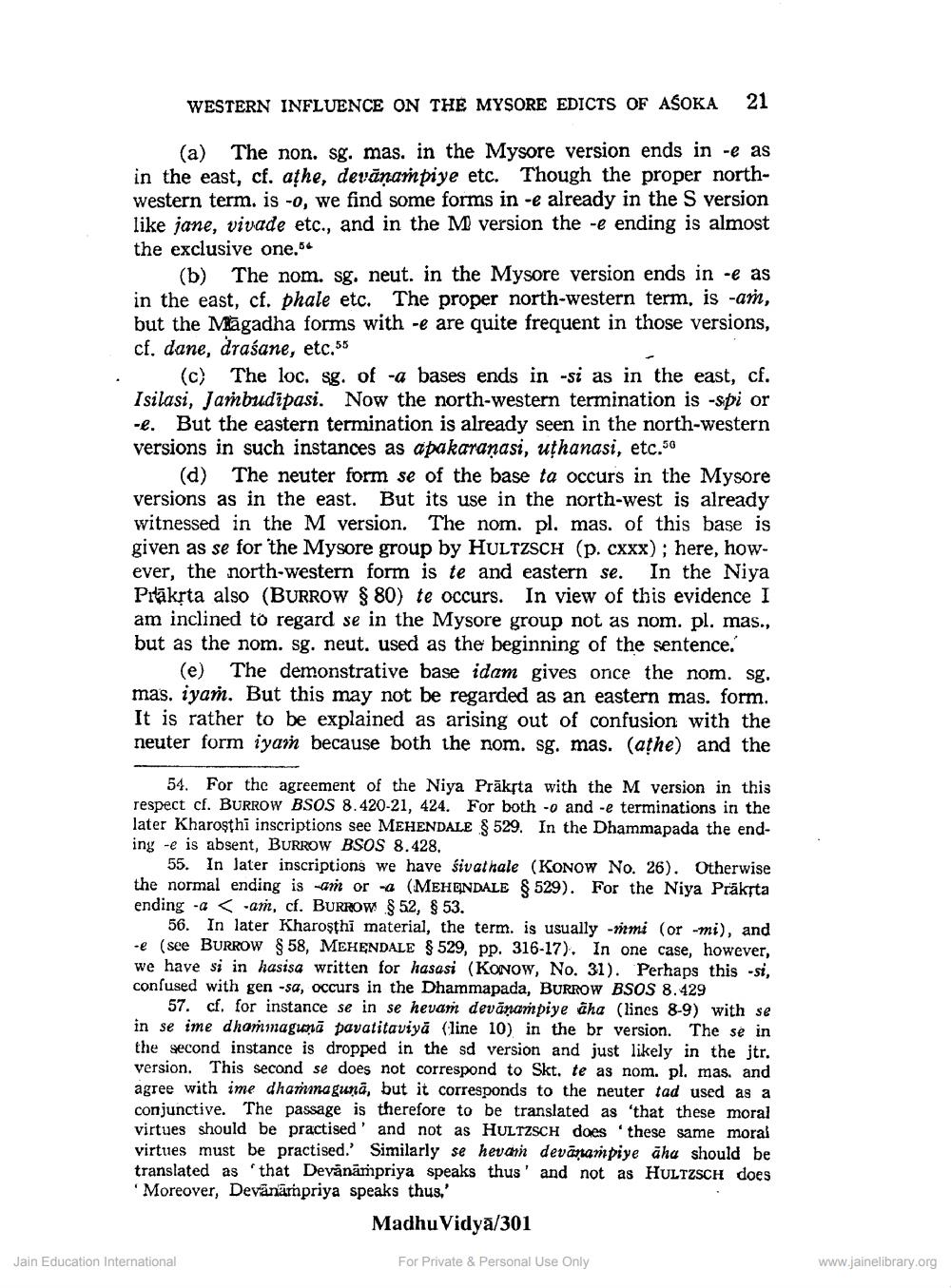________________
WESTERN INFLUENCE ON THE MYSORE EDICTS OF ASOKA
21
(a) The non. sg. mas, in the Mysore version ends in -e as in the east, cf. athe, devānampiye etc. Though the proper northwestern term.is -0, we find some forms in -e already in the S version like jane, vivade etc., and in the M version the -e ending is almost the exclusive one.54
(b) The nom. sg. neut. in the Mysore version ends in -e as in the east, cf. phale etc. The proper north-western term, is -am, but the Magadha forms with -e are quite frequent in those versions, cf, dane, draśane, etc.55
(c) The loc. sg. of -a bases ends in -si as in the east, cf. Isilasi, Jambudipasi. Now the north-western termination is -spi or -e. But the eastern termination is already seen in the north-western versions in such instances as apakaranasi, uthanasi, etc.56
(d) The neuter form se of the base ta occurs in the Mysore versions as in the east. But its use in the north-west is already witnessed in the M version. The nom. pl. mas. of this base is given as se for the Mysore group by HULTZSCH (p. cxxx); here, however, the north-western form is te and eastern se. In the Niya Pitākşta also (BURROW $ 80) te occurs. In view of this evidence I am inclined to regard se in the Mysore group not as nom. pl. mas., but as the nom. sg. neut. used as the beginning of the sentence.
(e) The demonstrative base idam gives once the nom. sg. mas. iyam. But this may not be regarded as an eastern mas. form. It is rather to be explained as arising out of confusion with the neuter form iyam because both the nom. sg. mas. (athe) and the
54. For the agreement of the Niya Prākta with the M version in this respect cf. BURROW BSOS 8.420-21, 424. For both -o and -e terminations in the later Kharoşthi inscriptions see MEHENDALE $ 529. In the Dhammapada the endiny -e is absent, BURROW BSOS 8.428.
55. In later inscriptions we have sivat hale (KONOW No. 26). Otherwise the normal ending is -am or -a (MEHENDALE $529). For the Niya Prākta ending -a < -am, cf. BURROW $ 52, $ 53.
56. In later Kharosthi material, the term. is usually -mmi (or -mi), and - (see BURROW $ 58, MEHENDALE $529, pp. 316-17). In one case, however, we have si in hasisa written for hasasi (KONOW, No. 31). Perhaps this -st, confused with gen -sa, occurs in the Dhammapada, BURROW BSOS 8.429
57. cf. for instance se in se hevam devānampiye dha (lines 8-9) with se in se ime dhammagunā pavatitaviyā (line 10) in the br version. The se in the second instance is dropped in the sd version and just likely in the jtr. version. This second se does not correspond to Skt. te as nom. pl. mas, and agree with ime dhamina gunā, but it corresponds to the neuter tad used as a conjunctive. The passage is therefore to be translated as 'that these moral virtues should be practised' and not as HULTZSCH does these same moral virtues must be practised.' Similarly se hevarn devānampiye āha should be translated as 'that Devänāmpriya speaks thus' and not as HULTZSCH does Moreover, Devānāmpriya speaks thus,'
Madhu Vidya/301
Jain Education International
For Private & Personal Use Only
www.jainelibrary.org




